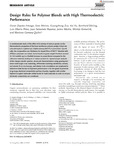Design Rules for Polymer Blends with High Thermoelectric Performance

Ver/
Use este enlace para citar
http://hdl.handle.net/2183/31051
A non ser que se indique outra cousa, a licenza do ítem descríbese como Atribución 4.0 International (CC BY 4.0)
Coleccións
- Investigación (EPEF) [590]
Metadatos
Mostrar o rexistro completo do ítemTítulo
Design Rules for Polymer Blends with High Thermoelectric PerformanceAutor(es)
Data
2022-04-07Cita bibliográfica
Zapata-Arteaga, O., Marina, S., Zuo, G., Xu, K., Dörling, B., Pérez, L. A., Reparaz, J. S., Martín, J., Kemerink, M., Campoy-Quiles, M., Design Rules for Polymer Blends with High Thermoelectric Performance. Adv. Energy Mater. 2022, 12, 2104076. https://doi.org/10.1002/aenm.202104076
Resumo
[Abstract] A combinatorial study of the effect of in-mixing of various guests on the
thermoelectric properties of the host workhorse polymer poly[2,5-bis(3-tetradecylthiophen-
2-yl)thieno[3,2-b]thiophene] (PBTTT) is presented. Specifically, the composition and thickness for doped films of PBTTT blended with different polymers are varied. Some blends at guest weight fractions around 10–15% exhibit up to a fivefold increase in power factor compared to the reference material, leading to zT values around 0.1. Spectroscopic analysis
of the charge-transfer species, structural characterization using grazing-incidence
wide-angle X-ray scattering, differential scanning calorimetry, Raman, and atomic force microscopy, and Monte Carlo simulations are employed to determine that the key to improved performance is for the guest to promote long-range electrical connectivity and low disorder, together with similar highest occupied molecular orbital levels for both materials in order to ensure electronic connectivity are combined.
Palabras chave
Doping
Microstructure
Organic thermoelectrics
Orientation
Ternary
Microstructure
Organic thermoelectrics
Orientation
Ternary
Versión do editor
Dereitos
Atribución 4.0 International (CC BY 4.0)
ISSN
1614-6840






